7 Best Condenser Microphones Under $200 – Outstanding Value For Your Money
We may also earn commissions on purchases from other retail websites.
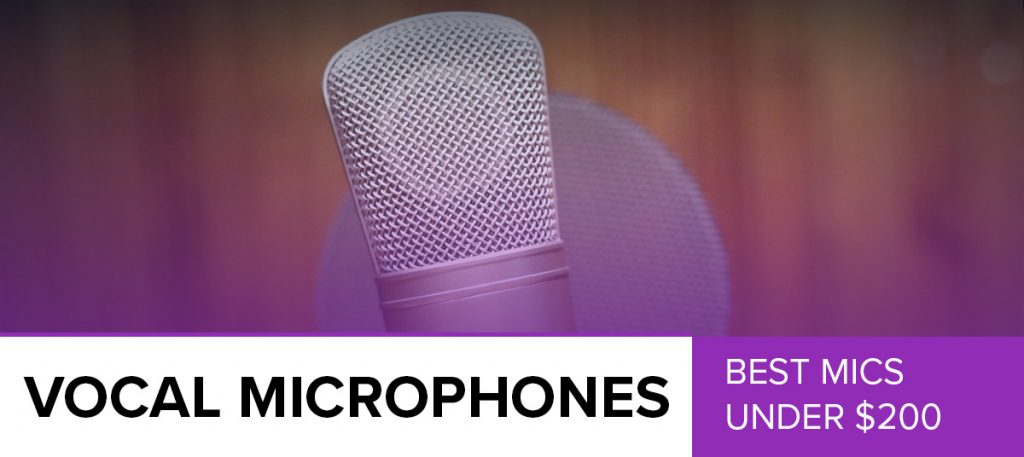
Last Updated: November-27-2018
In our latest refresh of this article on condenser mics in the sub-$200 range (aka, ‘the sweet spot’), we tweaked the content to bring it up to date, as well as changed a few models in our chart. We removed both the MXL 9000 and Blue Spark, and replaced them with the vocalist-friendly Blue Blackout Spark SL and a longstanding classic, the AKG C1000S.
Making the step up from an entry-level condenser microphone to one that comes in at around $200 can be a liberating experience. While they may not be the best condenser mics on the market, the models in this range tend to deliver both a strong performance and impressive features – but still at a price that doesn’t ruin you financially!
In this article we are going to highlight our favorite picks in the under $200 category. We’ll take a look at them individually in their full reviews, while the rest of our guide is dedicated to taking a look at what you can expect from a $200 condenser microphone. Ready? Let’s begin!Top 7 Condenser Microphones Under $200
| Image | Microphones / Rating | Summary | Check Price |
|---|---|---|---|
+ -  | AKG P420 Total of 4.28/5 | A workhorse that brings clarity and versatility at a really great price. | |
+ -  | Audio-Technica AT2035 Total of 4.22/5 | A worthy successor of a legendary microphone that packs even more versatility. | |
+ - 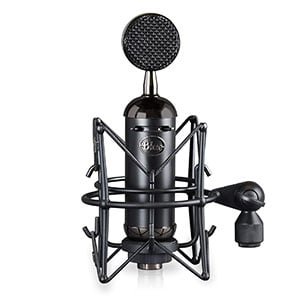 | Blue Blackout Spark SL Total of 4.70/5 | Good build and rich sound – a good choice for YouTubers. | |
+ -  | AKG 220 Total of 4.22/5 | Reliable, robust and sturdy no-nonsense performance in a very reasonably priced package. | |
+ -  | Shure SM86 Total of 4.17/5 | Ultimate versatility of a dynamic package with a classic condenser sound quality. | |
+ - 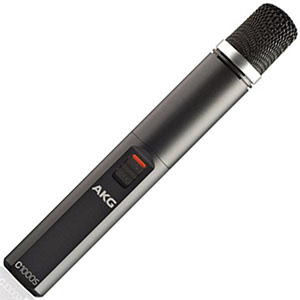 | AKG C1000S Total of 4.60/5 | An impressive new iteration of a classic condenser mic. | |
+ -  | Audio-Technica PRO 37 Total of 4.08/5 | One of the most versatile overhead mics in this particular market segment. |
AKG P420
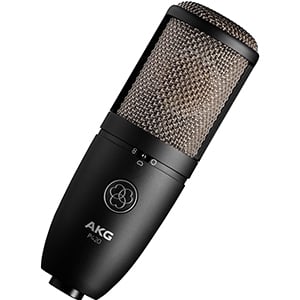
| Design: |  |
| Features: |  |
| Performance: |  |
| Value: |  |
he P420 is the first of two very similar condenser mics from AKG on this list (the other being the P220 below). However, the main benefit of this slightly higher priced mic is that it features a little more versatility.
This added flexibility comes in the form of a switch allowing you to choose between three different polar patterns: standard cardioid, omnidirectional or figure-eight patterns
Otherwise – as we highlight in the complete review of the AKG P420 – it’s a simple but effective side-address mic with great sound quality and a robust build. Well worth considering if you need to be flexible with how you record.
Audio-Technica AT2035
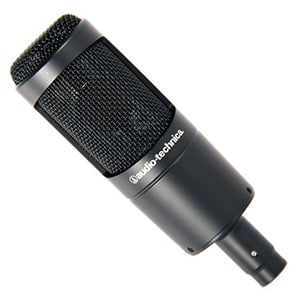
| Design: |  |
| Features: |  |
| Performance: |  |
| Value: |  |
The AT2035 from Audio-Technica is a superb sub-$200 condenser mic which works very well for recording both vocals and – with a decent max SPL of 148dB – instruments in a studio setting.
This versatile mic features a very stealthy all-black design with an excellent all-metal build quality for the price. The specs are solid and combine to deliver a great sound.
The addition of features like the 80Hz high-pass filter and 10dB pad are strong additions and give it extra value for money. There’s more on this workhorse of a mic in the full review of the AT2035.
Blue Blackout Spark SL

| Design: |  |
| Features: |  |
| Performance: |  |
| Value: |  |
From the unique aesthetics alone, you can tell the Blackout Spark SL is no ordinary microphone. With a cool lollipop design and stealthy all-black color scheme, it looks pretty high-end for its affordable price tag.
But it is more than just a pretty face – as we highlight in the complete Blackout Spark SL review. It offers a very rich and clear sound for vocalists, with a good noise cancelling abilities.
It’s not the best option for musical applications or instruments, but for talkers – everyone from podcasters to YouTubers – this mic is a strong choice.
AKG 220
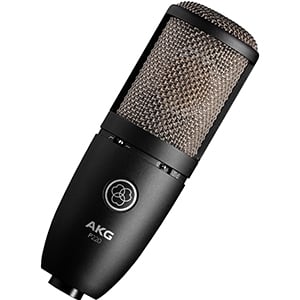
| Design: |  |
| Features: |  |
| Performance: |  |
| Value: |  |
If you can get by without the ability to switch between three different polar patterns, like the P420 above, AKG’s slightly cheaper fixed cardioid P220 may be a better mic for you.
With pretty much the same build and specs as the P420, this condenser mic still offers a highly versatile package that consistently delivers when recording both vocals and instruments, with a large max SPL of 155dB.
You also still get the handy attenuation and bass-cut switches, while the sound quality is impressive for a sub-$200 mic. Check out more on the AKG P220 in the complete review.
Shure SM86
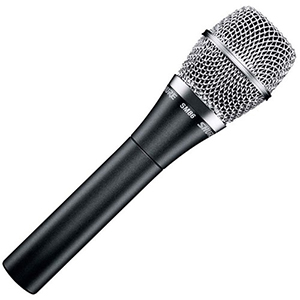
| Design: |  |
| Features: |  |
| Performance: |  |
| Value: |  |
While Shure’s bread and butter has always been dynamic microphones, there’s no surprise to see they have been able to craft an impressive condenser mic with some qualities of a dynamic mic.
This ultimately leads to a condenser mic that is as suitable for stage as it is studio, with the SM86 delivering clean and natural vocals, which are largely noise-free thanks to a built-in pop filter and shock mount.
The sleek but tough build quality means it can deal with a little rough handling too. Make sure to check out the main Shure SM86 review for all the details!
AKG C1000S

| Design: |  |
| Features: |  |
| Performance: |  |
| Value: |  |
A new addition to this list is a classic from AKG – the popular C1000S, which has been on sale in one way or another since the mid-1980s.
The overall solid design hasn’t changed much and it retains the chunky ‘thick stick’ build, which some people love (some… not so much).
Under the hood, the specs impress and – while the process of switching is a little cumbersome – features such as dual polar patterns and the ability to run this mic off batteries are very handy. There’s more in the complete review of the C1000S, so be sure to check it out!
Audio-Technica PRO 37
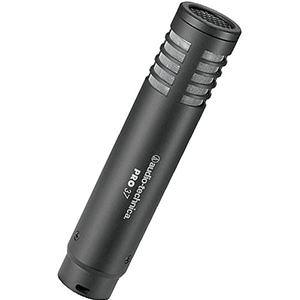
| Design: |  |
| Features: |  |
| Performance: |  |
| Value: |  |
Propping up this list is an overhead condenser mic that oozes quality! Audio-Technica’s PRO 37 delivers what is probably the best ratio of price to performance you can find at the moment.
While this affordable mic isn’t as versatile as your standard condenser, the PRO 37 is an excellent tool for recording instruments, with a high max SPL and plenty of boost to record even the subtlest acoustic instruments with utmost precision.
The compact design and the lightweight but durable build quality make it a mic that’s easy to work with in the studio – as we mention in the full PRO 37 review.
What Exactly Does a $200 Condenser Mic Offer?
We often refer to condenser mics in the $200 range as ‘hitting the sweet spot’. This is because they tend to offer a lot more in terms of features and performance compared to those in the entry-level range, yet not much less than those mics costing around $300.
There are several benefits of owning a sub-$200 condenser mic, some of which we are about to address below:
Design
This is a diverse price range, with many different types of condenser mic out there. Just take a look at the chart and you can see standard side-address mics as well as front address and overhead mics. You will also begin to find condenser microphones designed for use on stage. The actual design of microphones also begins to become broader, with brands having more of a budget to work with and therefore being able to offer more creative and attractive mic designs – look at brands like Blue Microphones and you’ll see what we mean.
Features
The increase in the number of features on offer is another important advantage of spending up to $200 on a microphone, as it can drastically improve the mic’s flexibility. While features differ from brand to brand, you will often see both a built-in attenuation pad (usually between -10dB to -20dB) and a high or low pass filter included as standard in this price range.
The attenuation switch is added to allow you to record instruments with a naturally high volume. For example, you can record acoustic guitars with just about any condenser microphone out there, but recording a drumkit, electric guitar or brass instruments tends to be trickier. Having built-in attenuation allows you to reduce the input volume, and thus eliminate the risk of damaging the mic by pushing it past its SPL capabilities. Meanwhile, a high or low pass filter will cut certain frequencies (bass or treble), depending on the type you go for.
Polar Patterns
Following on from features, another thing you begin to see more of in this price range is the addition of different polar pattern options. While some are still fixed cardioid patterns – which is nothing to be concerned about as this is the most popular setup – some will give you the option to switch to other patterns. These may include supercardioid/hypercardioid (focusing the direction of sound even further than standard cardioid); omnidirectional (making the mic sensitive to sound coming from all directions), or figure-8 (sensitive to sound coming from the front and rear of the mic).
Overall Quality
To be honest, even microphones in the budget market feature a very good build quality these days, so you can expect to see more of the same as you step up into the $200 price range. With that said, the quality of the components used can be better, as you start running into better capsules, more delicate diaphragms and more refined performance curves. It is also worth mentioning that microphones from this segment of the market usually arrive with good shock mounts and other accessories.
Where Are $200 Condensers Mics Used?
The majority of mics costing $200 or less are well suited to home recording, although are often found in all degree of professional studios around the world. Ultimately, just because there are microphones out there with astronomical price tags, it doesn’t mean that you can’t get the job done on a budget! The mics in this price range work well and sound awesome, so even professional producers and engineers will opt for them.
However, before you dive in and buy one, you will need to determine which mic fits your needs. Each of these microphones was built to meet specific requirements, so not every mic will be suitable for your purpose.
Is your main goal to record a drumkit? You won’t want to opt for a side-address podcasting mic with a low max SPL. Looking to record an orchestra? You will probably need something with omnidirectional capabilities. If you are a stage vocalist, you will require a mic that can cope with the added pressures of live applications. Do a little bit of research and buying a mic in this range will be a lot easier, leaving you with something you are more likely to get a lot of use from.
The Final Word
Building a recording studio on a budget is becoming easier and easier every year, especially when you consider the quality of condenser mics on offer today. The models listed above are all suitable for various applications in both home and professional studios.
They may not be the greatest condenser mics ever built, but they undoubtedly represent the best in this price range. Just make sure you do your research and you will end up with a solid mic that will give you years of use.


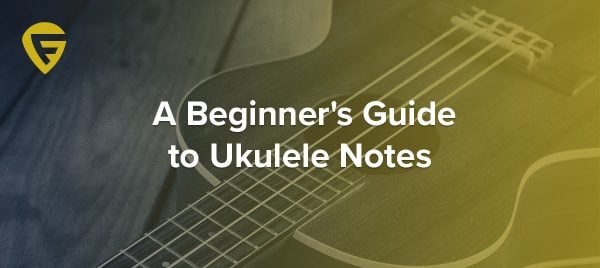
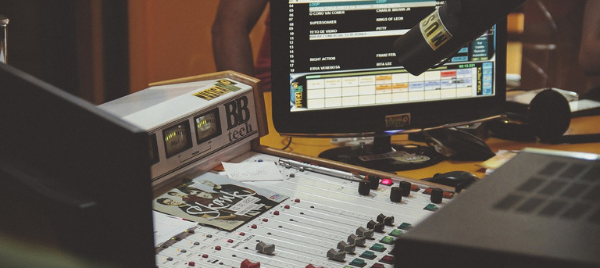
Reader Interactions